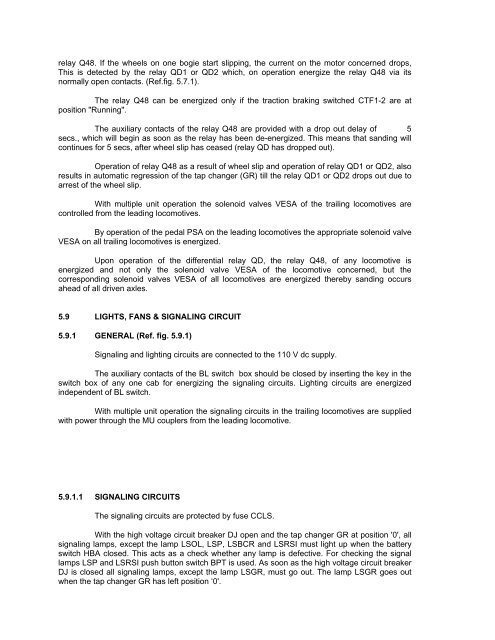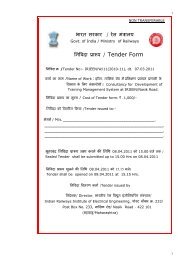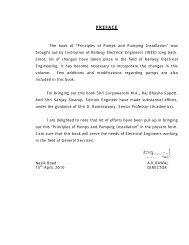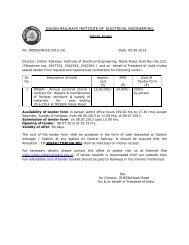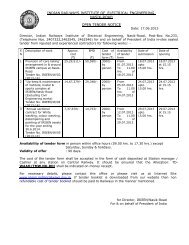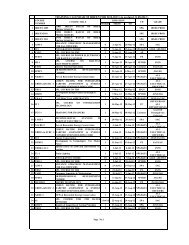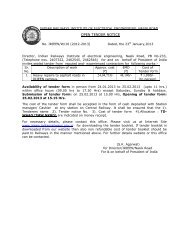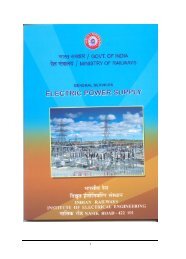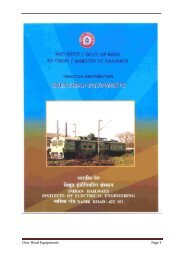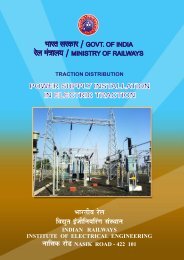Traction Rolling Stock - Indian Railways Institute of Electrical ...
Traction Rolling Stock - Indian Railways Institute of Electrical ...
Traction Rolling Stock - Indian Railways Institute of Electrical ...
You also want an ePaper? Increase the reach of your titles
YUMPU automatically turns print PDFs into web optimized ePapers that Google loves.
elay Q48. If the wheels on one bogie start slipping, the current on the motor concerned drops,<br />
This is detected by the relay QD1 or QD2 which, on operation energize the relay Q48 via its<br />
normally open contacts. (Ref.fig. 5.7.1).<br />
The relay Q48 can be energized only if the traction braking switched CTF1-2 are at<br />
position "Running".<br />
The auxiliary contacts <strong>of</strong> the relay Q48 are provided with a drop out delay <strong>of</strong> 5<br />
secs., which will begin as soon as the relay has been de-energized. This means that sanding will<br />
continues for 5 secs, after wheel slip has ceased (relay QD has dropped out).<br />
Operation <strong>of</strong> relay Q48 as a result <strong>of</strong> wheel slip and operation <strong>of</strong> relay QD1 or QD2, also<br />
results in automatic regression <strong>of</strong> the tap changer (GR) till the relay QD1 or QD2 drops out due to<br />
arrest <strong>of</strong> the wheel slip.<br />
With multiple unit operation the solenoid valves VESA <strong>of</strong> the trailing locomotives are<br />
controlled from the leading locomotives.<br />
By operation <strong>of</strong> the pedal PSA on the leading locomotives the appropriate solenoid valve<br />
VESA on all trailing locomotives is energized.<br />
Upon operation <strong>of</strong> the differential relay QD, the relay Q48, <strong>of</strong> any locomotive is<br />
energized and not only the solenoid valve VESA <strong>of</strong> the locomotive concerned, but the<br />
corresponding solenoid valves VESA <strong>of</strong> all locomotives are energized thereby sanding occurs<br />
ahead <strong>of</strong> all driven axles.<br />
5.9 LIGHTS, FANS & SIGNALING CIRCUIT<br />
5.9.1 GENERAL (Ref. fig. 5.9.1)<br />
Signaling and lighting circuits are connected to the 110 V dc supply.<br />
The auxiliary contacts <strong>of</strong> the BL switch box should be closed by inserting the key in the<br />
switch box <strong>of</strong> any one cab for energizing the signaling circuits. Lighting circuits are energized<br />
independent <strong>of</strong> BL switch.<br />
With multiple unit operation the signaling circuits in the trailing locomotives are supplied<br />
with power through the MU couplers from the leading locomotive.<br />
5.9.1.1 SIGNALING CIRCUITS<br />
The signaling circuits are protected by fuse CCLS.<br />
With the high voltage circuit breaker DJ open and the tap changer GR at position '0', all<br />
signaling lamps, except the lamp LSOL, LSP, LSBCR and LSRSI must light up when the battery<br />
switch HBA closed. This acts as a check whether any lamp is defective. For checking the signal<br />
lamps LSP and LSRSI push button switch BPT is used. As soon as the high voltage circuit breaker<br />
DJ is closed all signaling lamps, except the lamp LSGR, must go out. The lamp LSGR goes out<br />
when the tap changer GR has left position ‘0'.


